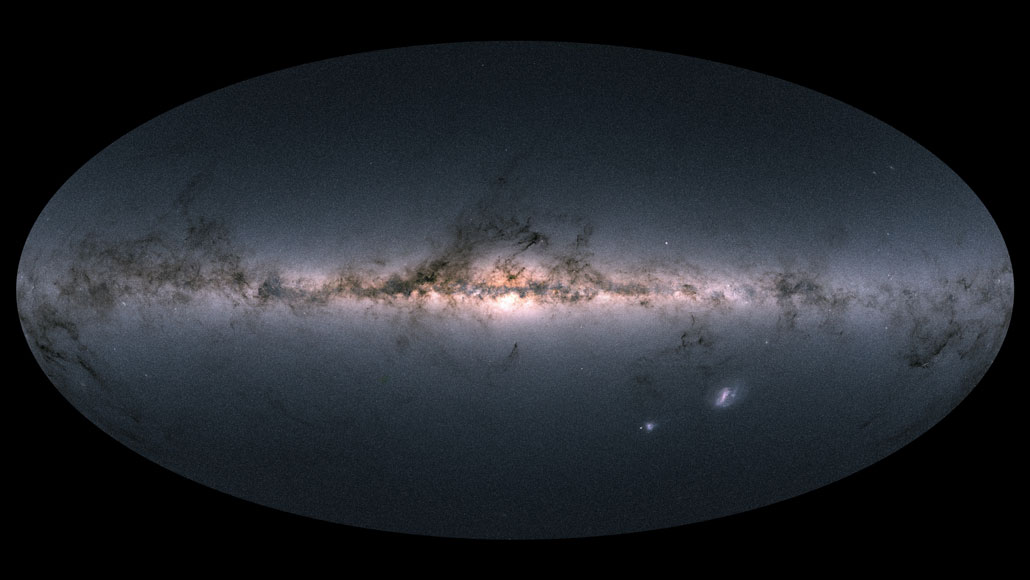The Milky Way may have grown up faster than astronomers suspected
Most of the galaxy’s disk was in place before a major collision 10 billion years ago

Much of the Milky Way’s characteristic disk (seen edge-on in this image from the Gaia spacecraft) was already in place 10 billion years ago, when an interloper galaxy called Gaia-Enceladus/Sausage collided with it.
DPAC/Gaia/ESA (CC BY-SA 3.0 IGO)
- More than 2 years ago
The Milky Way as we know it today was shaped by a collision with a dwarf galaxy about 10 billion years ago. But most of the modern galaxy was already in place even at that early date, new research shows.
Ages of stars left behind by the galactic interloper are a bit younger or on par with stars in the Milky Way’s main disk, researchers report May 17 in Nature Astronomy. And that could mean that the Milky Way grew up faster than astronomers expected, says study author Ted Mackereth, an astrophysicist at the University of Toronto.
“The Milky Way had already built up a lot of itself before this big merger happened,” he says.
Our galaxy’s history is one of violent conquest. Like other giant spiral galaxies in the universe, the Milky Way probably built up its bulk by colliding and merging with smaller galaxies over time. Stars from the unfortunate devoured galaxies got mixed into the Milky Way like cream into coffee, making it difficult to figure out what the galaxies were like before they merged.
In 2018, astronomers realized that they could identify stars from the last major merger using detailed maps of several million stars from the European Space Agency’s Gaia spacecraft (SN: 5/9/18). Streams of stars orbit the galactic center at an angle to the main disk of stars. Those stars’ motions and chemistries suggest they once belonged to a separate galaxy that plunged into the Milky Way about 10 billion years ago (SN: 11/1/2018).
“Those stars are left there like fossil remnants of the galaxy,” Mackereth says.
Two groups discovered evidence of the ancient galaxy at around the same time. One called the galaxy Gaia-Enceladus; the other group called it the Sausage. The name that stuck was Gaia-Enceladus/Sausage.
Mackereth and his colleagues wondered if they could figure out how well developed the Milky Way was when Gaia-Enceladus/Sausage came crashing in. If the oldest stars in the Milky Way’s disk formed after this merger, then they probably formed as a result of this collision, suggesting that Gaia-Enceladus/Sausage met a proto–Milky Way that still had a lot of growing up to do. On the other hand, if the oldest stars are about the same age or older than the stars from the galactic interloper, then our galaxy was probably pretty well developed at the time of the run-in.
Previous researchers had made estimates. But Mackereth and his colleagues used a precise tool called asteroseismology to figure out the ages of individual stars from both the Milky Way and from Gaia-Enceladus/Sausage (SN: 8/2/19). Just like seismologists on Earth use earthquakes to probe the interior of our planet, asteroseismologists use variations in brightness caused by starquakes and other oscillations to probe the innards of stars.
“Asteroseismology is the only way we have to access the internal part of the stars,” says physicist and study coauthor Josefina Montalbán of the University of Birmingham in England. From intel on the star’s interior structures, researchers can deduce the stars’ ages.
The team selected about 95 stars that had been observed by NASA’s exoplanet-hunting Kepler space telescope, which ended its mission in 2018 (SN: 10/30/18). Six of those stars were from Gaia-Enceladus/Sausage, and the rest were from the Milky Way’s thick disk. By measuring how the brightnesses of those stars fluttered over time, Mackereth and colleagues deduced ages with about 11 percent precision.
The Gaia-Enceladus/Sausage stars are slightly younger than the Milky Way stars, but all were pretty close to 10 billion years old, the team found. That suggests that a large chunk of the Milky Way’s disk was already in place when Gaia-Enceladus/Sausage came crashing through. It’s still possible that the incoming galaxy sparked the formation of some new stars, though, Mackereth says. To tell how much, they’ll need to get ages of a lot more stars.
Measuring ages for individual stars represents a step forward for galactic astronomy, says astrophysicist Tomás Ruiz-Lara of the University of Groningen, the Netherlands, who studies galactic evolution but was not involved in the new work.
“If you cannot tell the difference between a kid and a teenager and an adult, then we cannot say anything” about a population of people, Ruiz-Lara says. “But if I can distinguish between someone in his 40s or her 50s, you have a better graph of society. With the stars, it’s the same. If we are able to distinguish the age properly, then we can distinguish individual events in the history of the galaxy. In the end, that’s the goal.”







